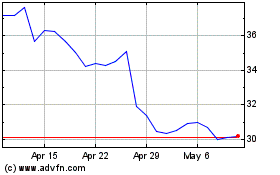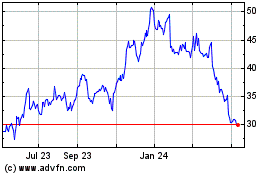Intel's SK Hynix Deal Will Make Good Memories -- Heard on the Street
October 20 2020 - 7:36AM
Dow Jones News
By Jacky Wong
Intel's origin as a memory-chip company is already a distant
memory. Its latest deal just confirms that--and brings much-needed
consolidation to the industry.
Intel has agreed to sell its NAND flash memory-chip business to
South Korea's SK Hynix for about $9 billion, including its
manufacturing facilities in China's Dalian. The unit makes NAND
memory chips, which are used in storage from smartphones to
computers. Intel will keep its small Optane business, which makes
advanced memory chips used in data centers.
The deal makes sense for both parties. Intel gets cash to
reinvest into its core central-processing-unit business, which is
struggling to mass produce its most advanced chips. It will also
exit a low-margin business that requires massive capital
investment. Intel is only the sixth largest player in NAND, lacking
the scale to compete with market leaders such as Samsung
Electronics. It also got a good price: The deal values Intel's NAND
business at 1.7 times sales, compared with 1.1 times enterprise
value to sales for Western Digital, according to analysts at
Cowen.
For SK Hynix, the deal will help it to narrow the gap with
Samsung. SK Hynix and Intel combined had about 23% of the NAND
market in the second quarter, according to Taiwanese research firm
TrendForce. The transaction would put it ahead of Kioxia's 17% and
just behind Samsung's 31%. SK Hynix will also get a bigger piece of
the pie in the more lucrative enterprise solid-state drives. More
than 60% of SK Hynix's NAND revenue comes from the mobile market,
which is more price-competitive, according to TrendForce. It may
also sell its new products alongside its DRAM chips, used in
processing.
The deal also sparks hopes for even greater consolidation in the
NAND industry, as has already happened in DRAM. Western Digital
jumped 8% Monday while Toshiba, which owns about a 40% stake in
Kioxia, rose 4% Tuesday. Competition in DRAM is less intense as the
market is effectively dominated by only three players: Samsung, SK
Hynix and Micron.
The NAND market, in contrast, still had six major players before
the deal. With one less player, the market expects less intense
competition and better margins while some smaller players may also
be bought.
Not all acquisitions make sense--especially in this era of
dizzying tech valuations--but for Intel and SK Hynix, this deal
looks likely to compute.
Write to Jacky Wong at JACKY.WONG@wsj.com
(END) Dow Jones Newswires
October 20, 2020 07:21 ET (11:21 GMT)
Copyright (c) 2020 Dow Jones & Company, Inc.
Intel (NASDAQ:INTC)
Historical Stock Chart
From Mar 2024 to Apr 2024

Intel (NASDAQ:INTC)
Historical Stock Chart
From Apr 2023 to Apr 2024
